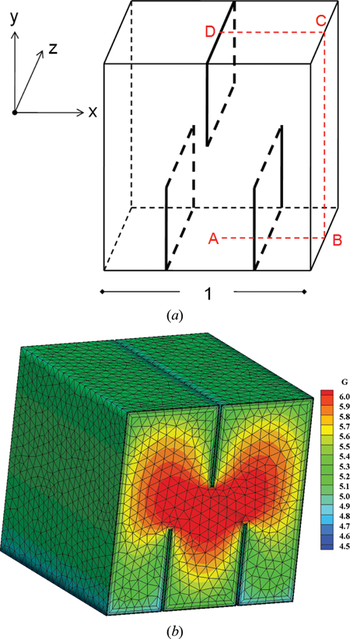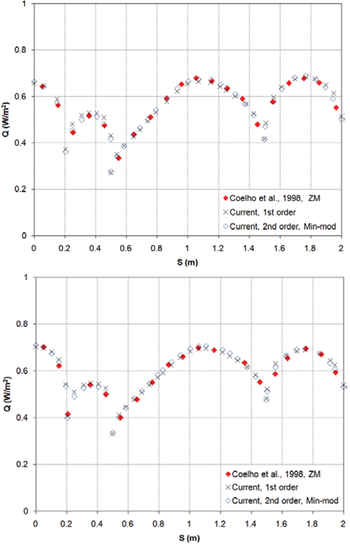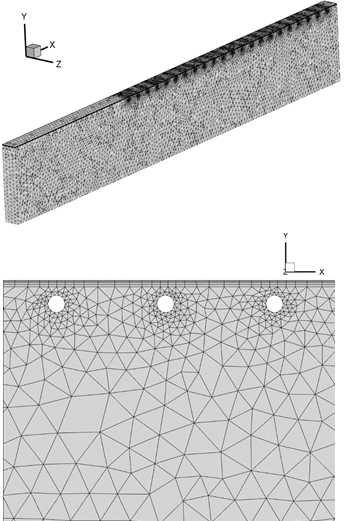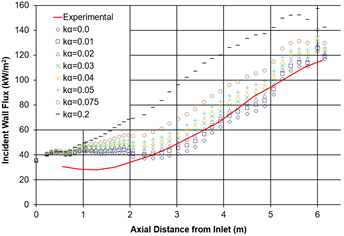Galatea-Rad solver is a discrete module of the Galatea CFD solver, written in Fortran and developed by members of the Turbomachines & Fluid Dynamics Laboratory (TurboLab-TUC). It solves the time-dependent RTE (Radiative Transfer Equation) to predict radiative heat transfer in general enclosures through absorbing, emitting, and either isotropically or anisotropically scattering gray media, for steady-state and transient problems.
The Finite Volume (FV) method is employed for the discretization of the computational domain and consequently of the RTE (both spatial and angular). For the spatial discretization a node-centered median-dual control volume method is applied, according to which the control cell of each mesh node is constructed by connecting with lines edge mid-points, barycenters of faces, and barycenters of elements that share this node. In a similar manner, angular discretization is succeeded by following an equal division strategy of the 4π steradians. The resulting directional weights (from the integration of RTE in each control volume) are defined using the step scheme, according to which the radiative intensity at a downstream face is set equal to that of its upstream node. Due to the combination of unstructured grids with the angular division of the computational field, overlapped directional weights arise; their effect is considerably reduced employing the pixelation method and consequently the appropriately transformed directional weights. An edge-based data structure increases the efficiency of the computational procedure.
A second-order accurate spatial scheme, based on the well-established in CFD (Computational Fluid Dynamics) MUSCL approach is applied to reduce false scattering, derived by the finite spatial discretization of the computational domain. To control the reconstructed values, especially at boundary areas involving large gradients, this second-order scheme can be coupled with the Van Albada-Van Leer or the Min-mod slope limiters.
For the iterative relaxation of the time-dependent RTE and consequently the approximation of the final steady state, an explicit second-order accurate in time four-stage Runge-Kutta method (RK(4)) is applied. A non-time-dependent RTE, along with simple iterative approximations, has also been incorporated in the solver. Nevertheless, the RK(4) method along with the time-dependent RTE is preferred, because the alternative combination has been proven susceptible to lead to oscillations when it is coupled with a high-order scheme, especially during the initial iterative steps.
Appropriate methods have been included in the solver for the acceleration of its solution procedure: a local time-stepping technique, parallel processing and an agglomeration multigrid scheme. The developed SPMD (Single Program Multiple Data) parallelization strategy is based on the domain decomposition approach and the MPI communication protocol. The agglomeration multigrid scheme, considers the generation of progressively coarser meshes at each sub-domain by merging (either isotropically or directionally) the adjacent control volumes in a way resembling the advancing front technique. The developed full-coarsening directional approach is intended for prismatic or hexahedral regions of hybrid grids. In a similar manner angular agglomeration of the neighbouring solid control angles can be performed. The only spatial, only angular, or spatial/angular agglomeration multigrid accelerated solution is obtained finally with the FAS (Full Approximation Scheme) method in a V-cycle process. Otherwise, a hybrid FMG-FAS (Full Multigrid - Full Approximation Scheme) approach can be selected, further increasing the efficiency of the solver.
[Galatea was a Nereid who was loved by the Cyclops Polyphemus (in Greek mythology). Nereids (sea Nymphs of Greek mythology) were the daughters of the sea god Nereus and of Doris, daughter of Oceanus].
References:
G.N. Lygidakis, I.K. Nikolos, "Using the Finite-Volume Method and Hybrid Unstructured Meshes to Compute Radiative Heat Transfer in 3-D Geometries", Numerical Heat Transfer, Part B Fundamentals, 62, pp. 289-314, 2012. https://doi.org/10.1080/10407790.2012.707012
G.N. Lygidakis, I.K. Nikolos, "A parallelized node-centered finite volume method for computing radiative heat transfer on 3D unstructured hybrid grids", Proceedings of the ASME 2012 11th Biennial Conference on Engineering Systems Design and Analysis, ESDA 2012, July 2-4, Nantes, France, Paper No. ESDA2012-82331. Volume 1 - ISBN No: 978-0-7918-4484-7. https://doi.org/10.1115/ESDA2012-82331
G.N. Lygidakis, I.K. Nikolos, "Using a High-Order Spatial/Temporal Scheme and Grid Adaptation with a Finite-Volume Method for Radiative Heat Transfer", Numerical Heat Transfer, Part B Fundamentals, 64, pp. 89-117, 2013. https://doi.org/10.1080/10407790.2013.784129
G.N. Lygidakis, I.K. Nikolos, "Improving the accuracy of a finite volume method for computing radiative heat transfer in three-dimensional unstructured meshes", SEECCM III, 3rd South-East European Conference on Computational Mechanics - an ECCOMAS and IACM Special Interest Conference, M. Papadrakakis, M. Kojic, I. Tuncer, V. Papadopoulos (Eds.), Kos Island, Greece, 12-14 June, 2013. DOI: 10.7712/130113.4412.S2043
G.N. Lygidakis, I.K. Nikolos, "Using a Parallel Spatial/Angular Agglomeration Multigrid Scheme to Accelerate the FVM Radiative Heat Transfer Computation—Part I: Methodology", Numerical Heat Transfer, Part B Fundamentals, 66, pp. 471-497, 2014. https://doi.org/10.1080/10407790.2014.949561
G.N. Lygidakis, I.K. Nikolos, "Using a Parallel Spatial/Angular Agglomeration Multigrid Scheme to Accelerate the FVM Radiative Heat Transfer Computation—Part II: Numerical Results", Numerical Heat Transfer, Part B Fundamentals, 66, pp. 498-525, 2014. https://doi.org/10.1080/10407790.2014.949509
G.N. Lygidakis, I.K. Nikolos, "A parallel finite-volume spatial/angular agglomeration multigrid method for radiative heat transfer computation", HEAT TRANSFER 2014, 13th International Conference on Simulation and Experiments in Heat Transfer and its Applications, A Coruna, Spain, 2-4 July, 2014. DOI: 10.2495/HT140251
G.N. Lygidakis, On the numerical solution of compressible flow and radiative heat transfer problems, Ph.D. Thesis, School of Production Engineering & Management, Technical University of Crete, 10/3/2015.
G.N. Lygidakis, I.K. Nikolos, "Assessment of different spatial/angular agglomeration multigrid schemes for the acceleration of FVM radiative heat transfer computations", Numerical Heat Transfer, Part B Fundamentals, 69 (5), pp. 389-412, 2016. https://doi.org/10.1080/10407790.2016.1138701
G.N. Lygidakis, I.K. Nikolos, "Comparison of different spatial/angular agglomeration multigrid schemes for radiative heat transfer computations", in M. Papadrakakis, V. Papadopoulos, G. Stefanou, V. Plevris (Eds.), Proceedings of the ECCOMAS Congress 2016, VII European Congress on Computational Methods in Applied Science and Engineering, Crete Island, Greece, 5-10 June, 2016. DOI: 10.7712/100016.2340.11423
G.N. Lygidakis, I.K. Nikolos, "Acceleration Strategies for Radiative Heat Transfer Simulations", Proceedings of the Fifth International Conference on Parallel, Distributed, Grid and Cloud Computing for Engineering, P. Ivanyi, B.H.V. Topping and G. Varady (Editors), Civil-Comp Press, Stirlingshire, Scotland, 2017.
G.N. Lygidakis, S.N. Leloudas, I.K. Nikolos, "Applying a Radiative Heat Transfer Finite-Volume Methodology to a Geometrically Complex Furnace", Proceedings of the ASME International Mechanical Engineering Congress and Exposition, IMECE 2018, 9-15 November, 2018, Pittsburgh, PA, USA, Paper No. IMECE2018-86831. https://doi.org/10.1115/IMECE2018-86831
Numerical Applications and Simulations







